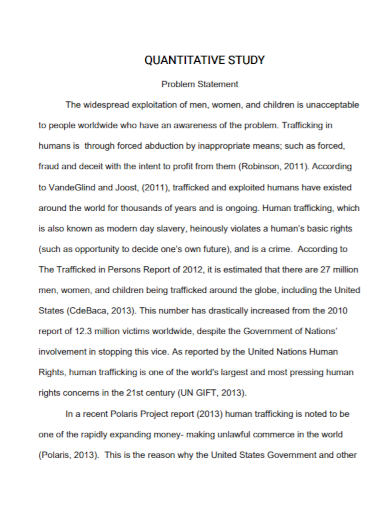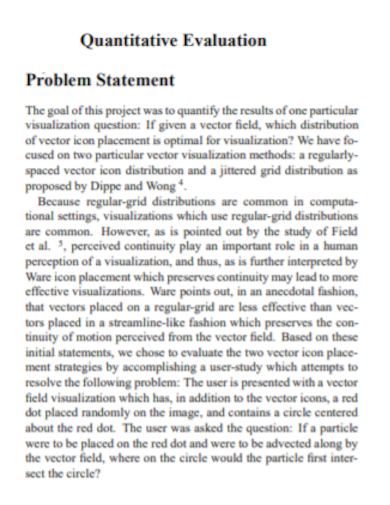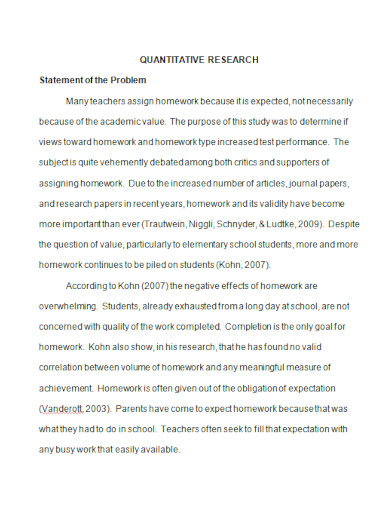Have you ever conducted a research yet? If so, you might be familiar with writing the research problem statement. Any remark regarding an issue that needs to be studied further, whether it’s in the form of an improvement, a problem to be solved, or a problematic topic that has been raised in academic literature, in theory, or in reality, indicates the need for further study. In every research project, the problem statement serves as a focus point and a link between the review of literature and the research technique. The issue, the solution technique, and the goal are all parts of a problem statement. A problem statement differs depending on what type your study plan would be. If you’re looking for some help in writing your statement, look no further! In this article, we provide you with free and ready-to-use samples Quantitative Problem Statements in PDF and DOC formats that you could use for your convenience. Keep on reading to find out more!
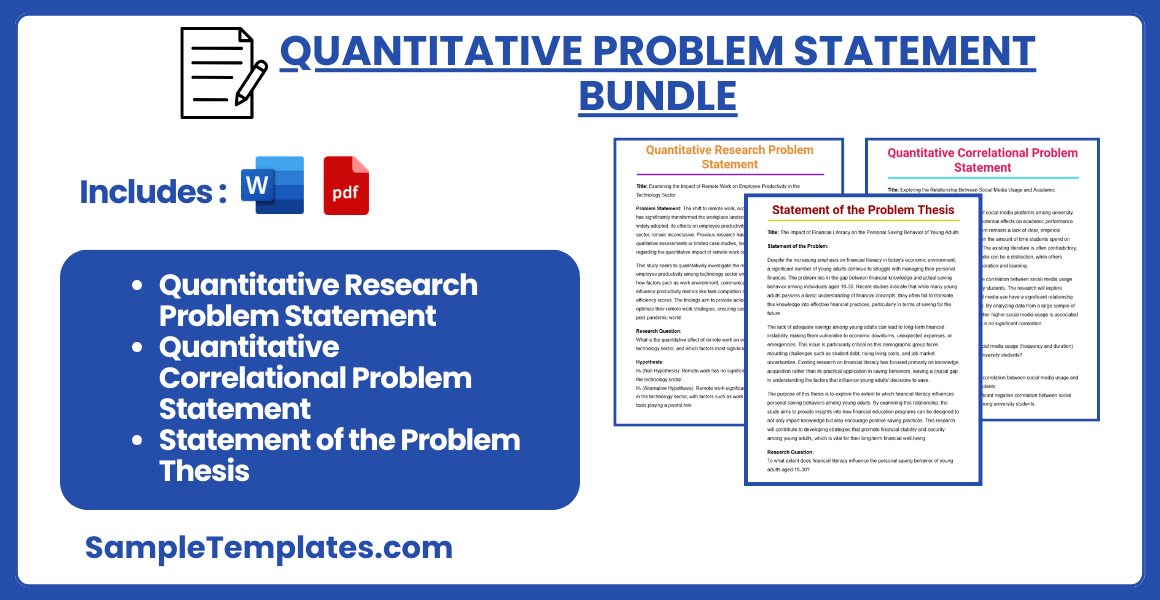
Download Quantitative Problem Statement Bundle
Quantitative Research Problem Statement
Title: Examining the Impact of Remote Work on Employee Productivity in the Technology Sector
Problem Statement: The shift to remote work, accelerated by the COVID-19 pandemic, has significantly transformed the workplace landscape. While remote work has been widely adopted, its effects on employee productivity, particularly within the technology sector, remain inconclusive. Previous research has predominantly focused on qualitative assessments or limited case studies, leaving a gap in empirical data regarding the quantitative impact of remote work on productivity levels.
This study seeks to quantitatively investigate the relationship between remote work and employee productivity among technology sector employees. Specifically, it will explore how factors such as work environment, communication tools, and remote work policies influence productivity metrics like task completion rates, error rates, and self-reported efficiency scores. The findings aim to provide actionable insights for companies to optimize their remote work strategies, ensuring sustained productivity in a post-pandemic world.
Research Question:
What is the quantitative effect of remote work on employee productivity in the technology sector, and which factors most significantly influence productivity levels?
Hypothesis:
H₀ (Null Hypothesis): Remote work has no significant impact on employee productivity in the technology sector.
H₁ (Alternative Hypothesis): Remote work significantly influences employee productivity in the technology sector, with factors such as work environment and communication tools playing a pivotal role.

Quantitative Correlational Problem Statement
Title: Exploring the Relationship Between Social Media Usage and Academic Performance Among University Students
Problem Statement: The widespread use of social media platforms among university students has raised concerns regarding its potential effects on academic performance. Despite extensive research on this topic, there remains a lack of clear, empirical evidence quantifying the relationship between the amount of time students spend on social media and their academic outcomes. The existing literature is often contradictory, with some studies suggesting that social media can be a distraction, while others propose that it may serve as a tool for collaboration and learning.
This study aims to quantitatively examine the correlation between social media usage and academic performance among university students. The research will explore whether the frequency and duration of social media use have a significant relationship with students’ Grade Point Averages (GPAs). By analyzing data from a large sample of students, the study seeks to determine whether higher social media usage is associated with lower academic performance or if there is no significant correlation.
Research Question:
Is there a significant correlation between social media usage (frequency and duration) and academic performance (GPA) among university students?
Hypothesis:
H₀ (Null Hypothesis): There is no significant correlation between social media usage and academic performance among university students.
H₁ (Alternative Hypothesis): There is a significant negative correlation between social media usage and academic performance among university students.
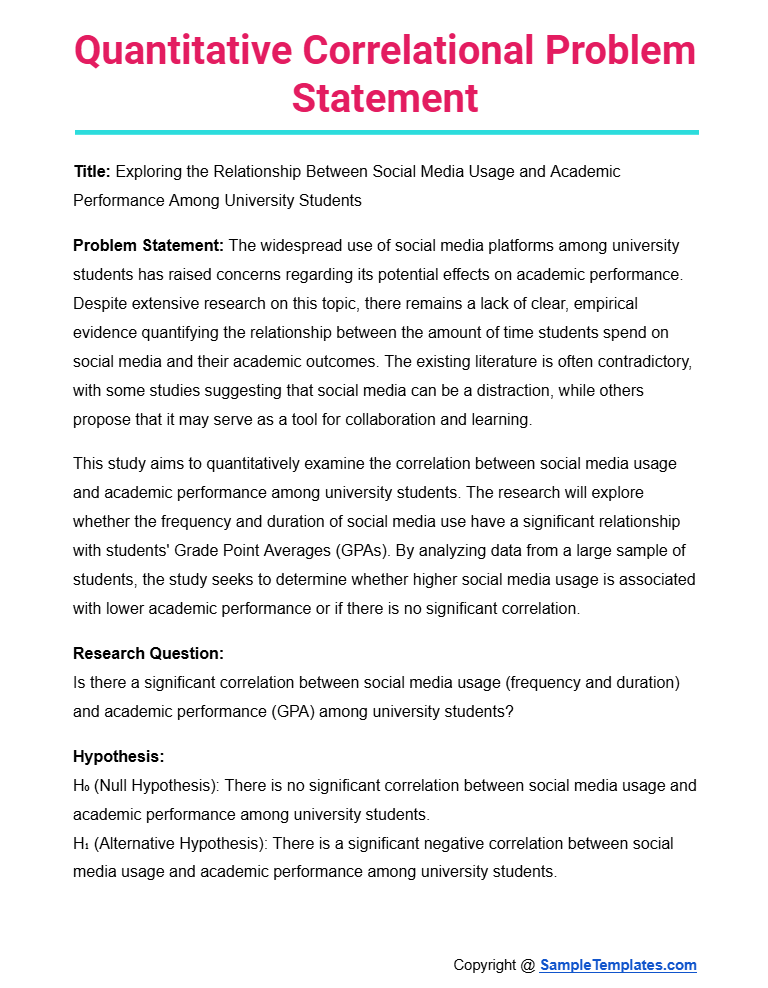
Statement of the Problem Thesis
Title: The Impact of Financial Literacy on the Personal Saving Behavior of Young Adults
Statement of the Problem:
Despite the increasing emphasis on financial literacy in today’s economic environment, a significant number of young adults continue to struggle with managing their personal finances. The problem lies in the gap between financial knowledge and actual saving behavior among individuals aged 18-30. Recent studies indicate that while many young adults possess a basic understanding of financial concepts, they often fail to translate this knowledge into effective financial practices, particularly in terms of saving for the future.
The lack of adequate savings among young adults can lead to long-term financial instability, making them vulnerable to economic downturns, unexpected expenses, or emergencies. This issue is particularly critical as this demographic group faces mounting challenges such as student debt, rising living costs, and job market uncertainties. Existing research on financial literacy has focused primarily on knowledge acquisition rather than its practical application in saving behaviors, leaving a crucial gap in understanding the factors that influence young adults’ decisions to save.
The purpose of this thesis is to explore the extent to which financial literacy influences personal saving behaviors among young adults. By examining this relationship, the study aims to provide insights into how financial education programs can be designed to not only impart knowledge but also encourage positive saving practices. This research will contribute to developing strategies that promote financial stability and security among young adults, which is vital for their long-term financial well-being.
Research Question:
To what extent does financial literacy influence the personal saving behavior of young adults aged 18-30?
Hypothesis:
H₀ (Null Hypothesis): Financial literacy has no significant impact on the personal saving behavior of young adults.
H₁ (Alternative Hypothesis): Higher levels of financial literacy are positively correlated with better personal saving behavior among young adults.
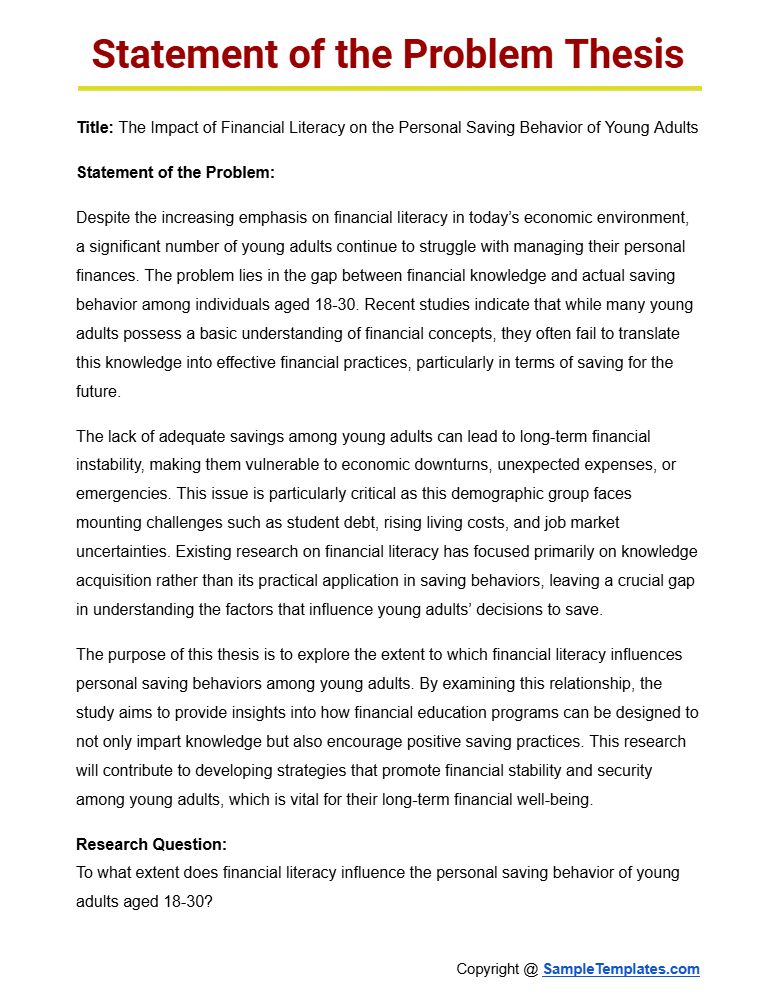
Browse More Templates On Quantitative Problem Statement
1. Quantitative Study Problem Statement Template
2. Quantitative Evaluation Problem Statement Template
What Is a Quantitative Problem Statement?
As a claim in quantitative research, a statement of the problem explains the problem being studied. The issue statement answers what the study seeks to uncover in a nutshell. A quantitative purpose statement, as opposed to a qualitative one, focuses on the relationships and correlations between numerical variables. These declarations of purpose will explain the goal or intention, identify the variables, and indicate the location of the research. A excellent research problem is one that fills a knowledge gap in the subject and inspires more study.
A quantitative problem statement is a key element in research, particularly in the fields of science, social sciences, and business. It serves as a concise and clear description of a specific issue or problem that can be addressed through quantitative research methods. The development of a well-crafted quantitative problem statement is a critical step in the research process as it helps researchers define the scope of work their study, establish research objectives, and determine the methodology to be used. In this article, we will explore what a quantitative problem statement is, its essential components, and the steps to create an effective one.
Components of a Quantitative Problem Statement
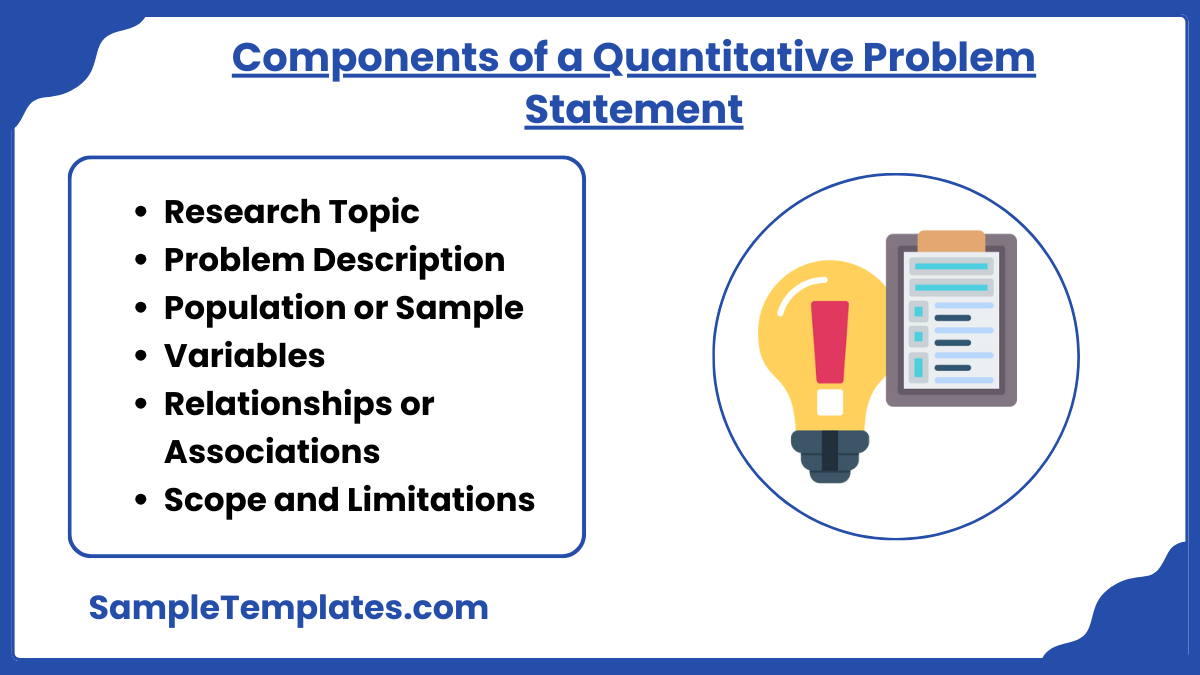
- Research Topic: The problem statement begins with a clear and concise presentation of the research topic or area of interest. It introduces the subject matter and context for the problem.
- Problem Description: The problem statement sample provides a detailed description of the issue or problem that the research aims to address. This description should be specific and well-defined, avoiding vague or overly broad statements.
- Population or Sample: Specify the population or sample that is the focus of the research. This could be a particular group, community, organization, or demographic segment relevant to the problem.
- Variables: Identify the key variables involved in the problem. These are the factors or elements that will be measured, observed, or manipulated in the study.
- Relationships or Associations: Describe any expected relationships, associations, or trends that the research seeks to explore or test. This may include hypotheses or research questions related to the variables.
- Scope and Limitations: Highlight the scope and limitations of the study. What aspects of the problem will be addressed, and what aspects will be excluded? This helps in defining the boundaries of the research.
3. Quantitative and Qualitative Problem Statement Template
Steps to Create a Quantitative Problem Statement
- Select a Research Topic: Choose a sample research analysis topic or area of interest that is significant and aligns with your research goals. Ensure it is specific enough to allow for focused investigation.
- Review the Literature: Conduct a thorough literature review to understand the existing knowledge and research related to the chosen topic. This will help you identify gaps in the literature and areas where quantitative research is needed.
- Define the Problem: Based on your literature review, define the specific problem you intend to address. Ensure it is well-defined, and use precise and unambiguous language to describe the problem.
- Identify Variables: Determine the key variables that are relevant to the problem. Variables can be independent (causes or predictors) and dependent (outcomes or responses).
- Formulate Hypotheses or Research Questions: Based on your problem statement and the identified variables, formulate hypotheses or research questions. These are statements or questions that express the expected relationships or associations you sample plan to investigate.
- Specify the Population or Sample: Define the population or sample that your research will focus on. This may include characteristics like age, gender, location, or any other relevant factors.
- Describe the Methodology: Briefly outline the quantitative research methods and techniques you intend to use to collect and analyze data. This provides an overview of your approach.
- Consider Ethical and Practical Issues: Address any ethical or practical considerations related to your research, such as obtaining informed consent or ensuring data privacy.
- State Scope and Limitations: Clearly state the scope of your study and its limitations. Acknowledge any constraints or factors that may affect the generalizability of your findings.
- Review and Refine: Review and refine your problem statement to ensure clarity, precision, and alignment with your research objectives.
4. Quantitative Research Problem Statement Template
How Do you Write a Quantitative Problem Statement?
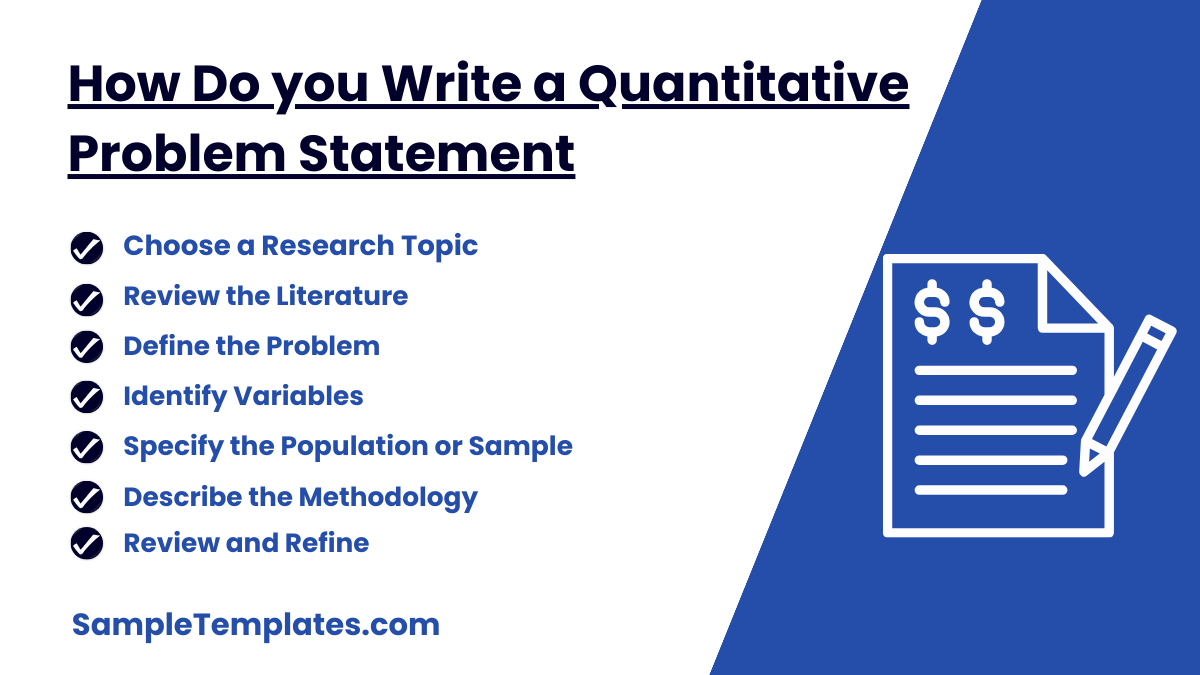
Writing a quantitative problem statement is a crucial step in the research process, as it lays the foundation for a focused and well-structured study. A well-crafted problem statement helps researchers define the research question, identify the variables to be measured, and sample outline the scope of their study. In this guide, we will discuss the step-by-step process of writing an effective quantitative problem statement.
Step 1: Choose a Research Topic
The first step in writing a quantitative problem statement is selecting a research topic. This topic should be of personal interest to you, have significance in your field, and align with your research goals. It’s essential to choose a topic that you are passionate about and motivated to investigate.
Step 2: Review the Literature
Before you can formulate a problem statement, it’s important to conduct a thorough literature review. This step helps you understand the current state of knowledge in your chosen research area and identify any gaps or unaddressed issues. Pay close attention to existing research studies and their findings to gain insights into the research landscape.
Step 3: Define the Problem
Based on your literature review, you can now define the specific problem you intend to address. To create a well-defined problem statement, consider the following:
- Be specific and concise: Clearly articulate the problem using precise and unambiguous language. Avoid vague or overly broad statements.
- Identify the gap: Describe the gap or deficiency in existing research that your case study aims to fill. Explain why this gap is significant and warrants investigation.
- Focus on relevance: Ensure that the problem is relevant to your field and contributes to the advancement of knowledge. It should address a real-world issue or concern.
- Use a declarative statement: Formulate your problem statement as a declarative sentence. For example, “The problem is that…”
Step 4: Identify Variables
In quantitative research, it’s essential to identify the key variables involved in the problem. Variables are factors or elements that you will measure, observe, or manipulate in your study. You need to determine which variables are relevant to your problem and how they relate to one another.
- Independent variables: These are the variables that you believe have an effect on the outcome. They are the causes or predictors.
- Dependent variables: These are the variables that represent the outcomes or responses you are interested in measuring.
Step 5: Formulate Hypotheses or Research Questions
Once you have defined the problem and identified the variables, you can formulate hypotheses or research questions. These are statements or questions that express the expected relationships or associations you plan to investigate in your study.
- Hypotheses: These are specific, testable statements that predict the relationship between variables. They typically follow the format “If [independent variable], then [dependent variable].”
- Research questions: These are open-ended questions that guide your inquiry. They do not make specific predictions but instead ask what the research aims to discover.
Step 6: Specify the Population or Sample
In your problem statement, specify the population or sample that your research will focus on. The population is the larger group to which your findings will be generalized, while the sample is the subset of the population that you will study.
- Characteristics: Define the characteristics of your population or sample, such as age, gender, location, or any other relevant factors.
Step 7: Describe the Methodology
While the problem statement primarily focuses on the research question, variables, and problem definition, you can briefly outline the quantitative research methods and techniques you intend to use to collect and analyze data. This provides an overview of your approach.
- Data collection methods: Mention the methods you will use to collect data, such as surveys, experiments, observations, or secondary data analysis.
- Data analysis techniques: Highlight the statistical techniques you plan to use for data analysis, such as regression analysis, ANOVA, or t-tests.
Step 8: Consider Ethical and Practical Issues
Acknowledge any ethical or practical considerations related to your research. This may include obtaining informed consent from participants, ensuring data privacy, or addressing potential biases in your study.
Step 9: State Scope and Limitations
Clearly state the scope of your study and its limitations. Acknowledge any constraints or factors that may affect the generalizability of your findings. This helps define the boundaries of your research.
Step 10: Review and Refine
After drafting your problem statement, review and refine it to ensure clarity, precision, and alignment with your research objectives. Seek feedback from peers, mentors, or advisors to enhance the quality of your problem statement.
FAQ
What is a problem?
A problem is a challenge or difficulty that hinders progress or causes distress. It requires resolution or mitigation through analysis, decision-making, and often, creative or strategic solutions.
What is an example of a quantitative problem?
A quantitative problem involves numerical data. For example, calculating profit margins, analyzing sales trends, or solving a mathematical equation in a business context are quantitative problems.
What are the most important elements of a quantitative goal statement
The most important elements of a quantitative goal statement are a clear research problem, defined variables, testable hypotheses or research questions, and a specified population or sample.
What is quantitative research’s major focus?
Quantitative research focuses on the collection of numerical sample data analysis and the generalization of it across groups of individuals or to explain a specific phenomena. The final written report has a predetermined format consisting of an introduction, literature and theory, methodology, findings, and a commentary.
What are the most common flaws in quantitative research?
The voice of the participant is absent from quantitative research Analysis. The fact that qualitative researchers do not attempt to generalize their results to a larger population is perhaps the most significant aspect of qualitative research.
What makes quantitative research so difficult?
It’s all about cold, hard facts when it comes to quantitative data. This type of study is fully data-driven and significantly more focused than qualitative studies. Because data collection in this approach is extremely strict and organized, tests and experiments must be conducted in a carefully controlled environment.
Finally, formulating the sequence of your research is aided by using a problem statement sample. Researching a topic helps you save time by eliminating processes that aren’t essential. A research challenge helps you better comprehend the research method. To help you get started with this, download our easily customizable and printable
Related Posts
FREE 10+ Medical Problem Statement Samples [ Surgical, Nursing, Management ]
FREE 10+ Payoff Statement Samples in PDF | DOC
FREE 10+ Scholarship Statement of Purpose Samples in PDF | DOC
FREE 10+ Engineering Problem Statement Samples [ Software, Mechanical, Civil ]
FREE 30+ Information Statement Samples in PDF | MS Word
FREE 50+ Policy Statement Samples in MS Word | Google Docs | PDF
FREE 50+ Summary Statement Samples in PDF | MS Word
FREE 10+ Nursing School Personal Statement in PDF
FREE 9+ Mortgage Statement Samples and Templates in PDF
FREE 10+ Independent Subcontractor Statement Samples in MS Word | Google Docs | Apple Pages | PDF
FREE 10+ Trust Distribution Statement Samples in PDF
FREE 14+ Compliance Statement Samples & Templates in PDF | MS Word
FREE 10+ Extension Impact Statement Samples in PDF | DOC
FREE 10+ Bank Reconciliation Statement Samples and Templates in PDF | MS Word
FREE 10+ Diversity Mission Statement Samples in MS Word | PDF

